
Table of Contents
"Weaver ants (Oecophylla smaragdina) with larvae" by Ria Tan. WildSingapore, 10 Sep 2003. URL: http://www.flickr.com/photos/wildsingapore/5571320554/in/set-72157604037043447/ (accessed on 3 Nov 2011).
Overview
Oecophylla smaragdina is widespread in the Old World tropics and are present the most sophisticated nest-building activities of all weaver ants.The weaver ant (O. smaragdina) is a dominant canopy ant in tropical India and Australasia with colonies of up to 500 000 ants housed in nests made of leaves fastened together by larval silk and scattered across tens of trees. Workers draw leaves together, often forming long chains, and glue them together with larval silk. The colonies are very large and highly polydomous. Queens are pre-dominantly though not exclusively once-mated and colonies are usually single-queened, but most Northern Territory (Australia) colonies are polygynous. The workers are highly polymorphic (seen also in a fossilized colony), show complex polyethism, and present a much-studied rich pheromonal repertoire for the colony's tasks. Colony odor is partly learned, showing a "nasty neighbor" effect in reactions to other colonies of this highly territorial ant, and partly intrinsic to each individual. The odor varies over time and differs between the nests of a colony. Not surprisingly, Oecophylla ants are hosts to a variety of inquilines, such as spiders, which mimic the colony odor to escape detection. In addition, a constellation of Homoptera benefit from ant protection, yet the activities of the ants in controlling pest species make these ants beneficial insects (they are also human food in some areas) (adapted from Crozier et al., 2010).Left video, 1st prize winner of Biotechnology and Biological Sciences Research Council (BBSRC) 2010 science photo competition: Link; Right video: National Geographic VideoLeft: "Cambridge Ideas-Sticky Feet" by Cambridge University. CambridgeUniversity Youtube Channel, 15 Feb 2010. URL:
http://www.youtube.com/watch?feature=player_embedded&v=hd5upt3IrWM (accessed on 26 Oct 2011).
Right: "Weaver Ants... on the Menu" by National Geographic. NationalGeographic Youtube Channel, 27 Apr 2011. URL:
http://www.youtube.com/watch?feature=player_embedded&v=OLO0jV__3Zw (accessed on 28 Oct 2011).
Biomimicry ApplicationsLarval SilkUsually, the organism that stands to benefit from using the silk is also the producer of the silk, but an interesting exception is provided by adult weaver ants that use larval silk as a structural component of their nests (Dorow //et al//. 1990). Widespread attempts to copy the molecular order in, and mechanical properties of, natural silk fibre have been prompted by the observation of how this material is deployed in nature and from measurements of the average strength and stiffness in standard (short-duration) tensile tests (Reed et al., 2009).Feet Adhesive PadsInsect adhesion is mediated by thin fluid films secreted into the contact zone. As the amount of fluid affects adhesive forces, a control of secretion appears probable. Oecophylla smaragdina ants were found to use only 14 per cent of their available contact area when walking upside down. This control of adhesive contact area may not only be important for reducing wear of adhesive pads and facilitating detachment, but also for limiting fluid loss (Dirks and Federle, 2011). |
Human Diet and UseFood and MedicineThroughout South-East Asia, weaver ants are a significant commercial product. In Java the larvae and pupae of weaver ants are harvested and sold as food for song birds or as fishing bait (Césard, 2004). Small larvae (either of workers or early instar queens) are preferred as bird food. In the markets, 1 kg of larvae sells for between US$3.5 and US$5.00 (Césard, 2004). In Thailand, large queen larvae and pupae are harvested as a food product for human consumption (Sribandit et al., 2008). This not only provides food for the family, but also as much as 30% of the total family income for collectors (Sribandit et al., 2008). In parts of India the workers themselves are consumed, and even used in the making of chutney (Oudhia, 2002). Extracts from the ants are used by Indian traditional healers to treat a range of common maladies (Oudhia, 2002).Biological Control AgentThe weaver ants are distinguished by their close control of their environment. Indeed. man has employed weaver ants to control the arboreal environment for him. Records from the Canton area of China show that weaver ant nests were gathered, sold and placed in selected citrus trees to combat insect pests in about A.D. 300. The same technique was noted in the 12th century and was still practiced in southern China well into the 20th century. This utilization of weaver ants is the oldest-known instance of the biological control of insects in the history of agriculture (Hölldober and Wilson, 1977).====Pest==== Although generally regarded as beneficial within the agricultural industry, O. smaragdina can also sometimes be regarded as a pest, being an opportunistic and aggressive feeder. Presence of Oecophylla nests on the trees statistically significantly lowered the flower-visiting rate of flying insects, involving the major pollinators. The visiting rate of Oecophylla workers to each flower shoot of rambutan significantly negatively correlated with the visiting rate of flying insects (Tsuji et al., 2004). Even when the benefits of weaver ants to the quality of mango fruit are acknowledged, the ants are still often regarded as a nuisance pest during harvesting (Sinzogan et al., 2008). The use of weaver ants as a biological control agent on coffee plantations in Sri Lanka has reportedly been abandoned for just this reason (Césard, 2004). |

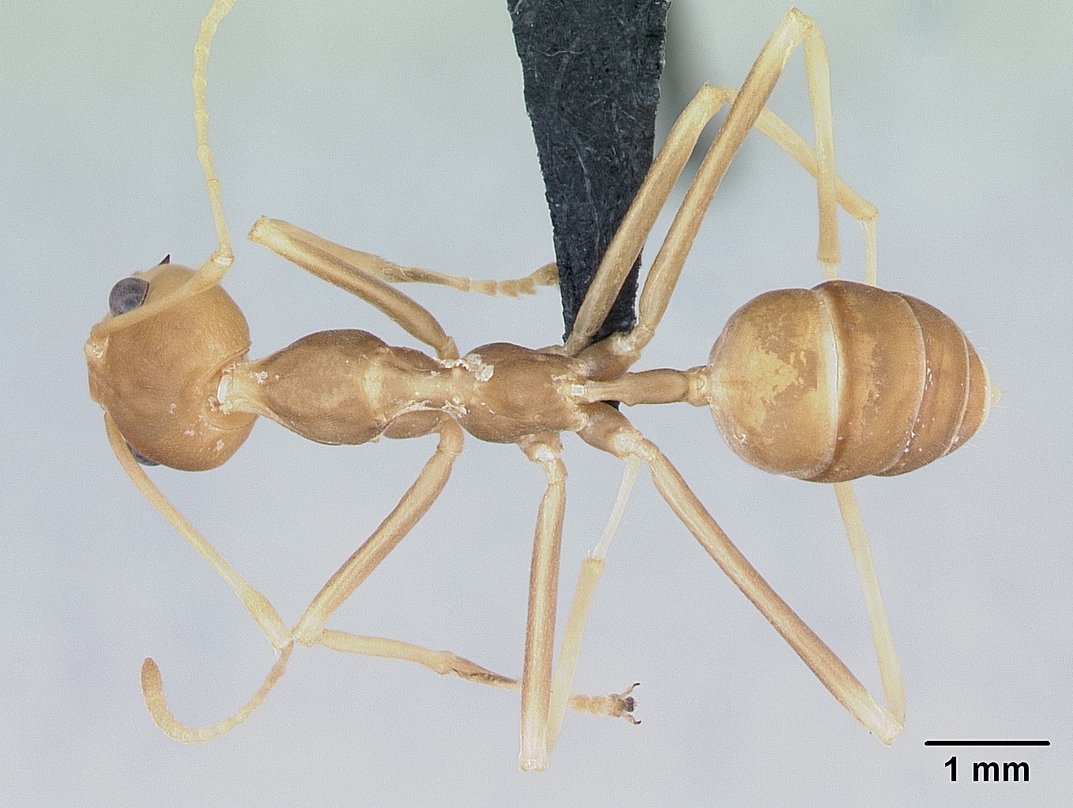 "Oecophylla smaragdina, Specimen: CASENT0173648. Closeup of profile [T], dorsal [B] of specimen CASENT0173648" by April Nobile. AntWeb, 12 Nov. 2007. URL: http://www.antweb.org/description.do?rank = species & name = & genus = Oecophylla smaragdina & project = (accessed 15 Oct 2011).
"Oecophylla smaragdina, Specimen: CASENT0173648. Closeup of profile [T], dorsal [B] of specimen CASENT0173648" by April Nobile. AntWeb, 12 Nov. 2007. URL: http://www.antweb.org/description.do?rank = species & name = & genus = Oecophylla smaragdina & project = (accessed 15 Oct 2011).Name
Scientific: Oecophylla smaragdina (Fabricius, 1775)
Vernacular: Weaver Ant , Green Ant, Green Tree A nt, Orange Gaster, Kerengga
Original description published under Formica smaragdina Fabricius, 1775. Systema Entomologiae, sistens insectorum classes, ordines, genera, species, adjectis synonymis, locis, descriptionibus, and observationibus: 828 (q.)
Etymology
How the name is derived
Genus - from the Latin word oeco (household) and Greek word φύλλο, phyllo (leaf).
Specific epithet - is derived from the Latin word smaragdinus (emerald-green) denoting the green color of the gaster (ants in Singapore have red gasters).
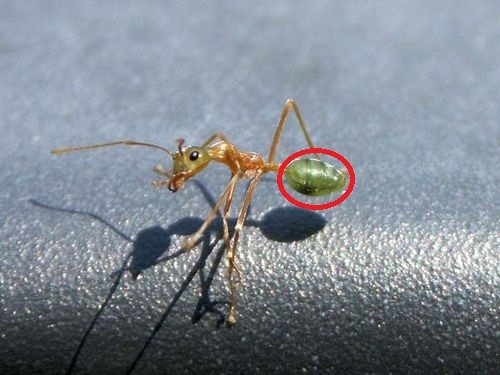 "Green Tree Ant (Oecophylla smaragdina) - Near Cape Tribulation - Queensland" by "Green Tree Ant (Oecophylla smaragdina) - Near Cape Tribulation - Queensland" by B. Didier. OZAnimals. URL: http://www.ozanimals.com/Insect/Green-Tree-Ant/Oecophylla/smaragdina.html(accessed on 17 Oct 2011). |
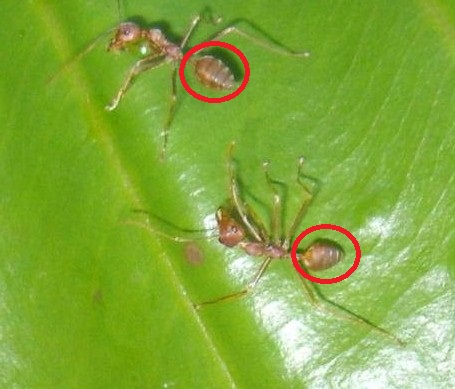 "Oecophylla smaragdina on Dillenia suffruticosa, Kent Ridge Road" by Reuben Lim(Taken on 11 Sep 2010). |
Occurrence in Singapore
The Asian Weaver Ant is widespread in disturbed areas and urban plantings, as they are able to construct their nests on many plants from trees, shrubs to tall grasses, and can control a vast area effectively. They occur in many parks as well, and can be a pest to humans that approach too close to their nests as they bite aggressively. Although not eaten in Singapore, many regional countries consider the weaver ant as part of their cuisine.Biology
Behaviour
O. smaragdina does not sting but produces painful bites with its sharp and powerful mandibles, intensified by irritating secretions from the mandibular glands. It also releases formic acid from the gaster which can cause irritation to human skin (Chung, 1995). They maintain exclusive territories and monopolize large aggregations of different trophobionts.They kill a large range of arthropods for food, exhibiting highly organized aggressive predatory behavior combined with extensive foraging throughout the area occupied by a colony. More aggression is showed towards neighbours than strangers, exhibiting the "nasty neighbour effect".Queen Mating Patterns
Colonies in the Northern Territory, Australia, are the most variable due to polygyny and polyandry. Colonies in Queensland, Australia, are mostly monogynous, although often polyandrous and thus overall less variable. The population in Java, Indonesia, shows the least variation in colony genetic structure, because most colonies are both monogynous and monandrous (Schlüns et al., 2009). No information is available for mating patterns in Singapore at this moment as research has not been performed.Division of Labour, Lifespan
The major (large) workers perform the risky tasks outside the nest, while the minor (small) workers stay within the highly protected arboreal nest. Hence, this pronounced division of labour is associated with high differences in extrinsic mortality risks. Minor workers have a longer lifespan than major workers, despite their smaller size and presumably higher metabolic rate per unit of mass (Chapuisat and Keller, 2002).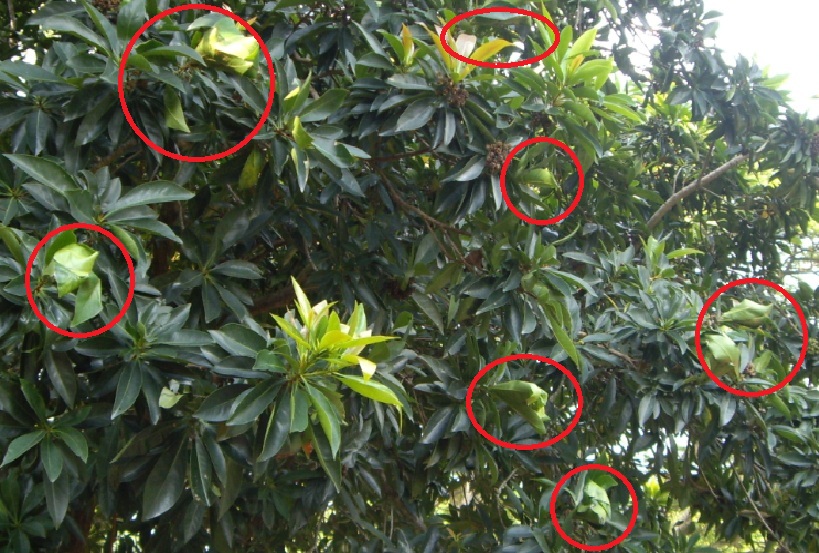 "Multiple Oecophylla smaragdina nests circled on Xanthostemon chrysanthus, Central Library, NUS." by Reuben Lim (Taken on 16 Oct 2010). "Multiple Oecophylla smaragdina nests circled on Xanthostemon chrysanthus, Central Library, NUS." by Reuben Lim (Taken on 16 Oct 2010). |
 "Closeup of nest on Arthrophyllum diversifolium" by Reuben Lim (Taken on 5 Dec 2010). "Closeup of nest on Arthrophyllum diversifolium" by Reuben Lim (Taken on 5 Dec 2010). |
Nest Building
Weaver ants are named for their method of nest construction. The nests are made of leaves folded or fastened together to form tight, tent-like compartments. The leaves are held in place by seams of silk spun by the larvae, which the major workers employ like shuttles for weaving the nests. This nest building is one of the most remarkable instances of social cooperation among lower animals. Once the weaver ants have chosen a tree branch suitable for a nest they spread out on the leaves of the branch and begin to pull on the tips and edges. When an ant succeeds in turning up a segment of a leaf, nearby workers are attracted to that part of the leaf. and soon there is a small group of ants pulling in unison.When a leaf is broader than the length of an ant's body. or when two leaves must be pulled together across a wide space. the workers form living bridges between the points to be joined. Then some of the ants in the chain climb onto the backs of their neighbors and pull backward, thus shortening the chain and bringing the leaf edges together. When the leaves have been maneuvered into shape, some of the ants remain on them, employing their legs and mandibles to hold the leaves in place. Other ants go back to already established nests and return to the new site carrying partly grown larvae. The workers wave the larvae back and forth across the leaf seams. This causes the larvae to release threads of silk from gland openings located just below their mouth. Thousands of these threads woven into sheets are strong enough to hold the leaves in place. Sheets of silk are also spun to make circular entrances and outer galleries leading to the interior of the new nest (Hölldober and Wilson, 1977).
 "Nest construction by Oecophylla smaragdina workers, Thailand" by S. Hoyland. Wikimedia Commons. URL:http://en.wikipedia.org/wiki/File:SSL11903p.jpg (accessed on 2 Jan 2012). |
Recruitment Strategy
In a colony in which odour cues are shared among workers, each worker may be described in terms of both an innate odour and an expressed odour. The innate odour is that which the individual would express if kept in isolation from the colony, and which presumably has a genetic basis. The expressed odour is the odour that results from the mixing of cues among workers via trophollaxis and allo-grooming and, depending upon the efficiency with which odour is shared, will be similar for all workers. This odour may also be influenced by environmental factors such as diet and nest substrate. In colonies with low genetic diversity, it maybe possible for a zone of tolerance to encompass the few odour phenotypes that exist within the colony, without greatly increasing the probability of mistaking a non-nestmate for a nestmate (Type II error). The sharing of recognition cues among workers again reduces the number of phenotypes within the colony, potentially to a single phenotype. This is an explanation for why the level of aggression expressed by a colony decreases as the diversity within the colony increases, even when odour is well-mixed (Newey, 2011). From: Hölldober and Wilson, 1977
From: Hölldober and Wilson, 1977Associations with other animalsOne of the most closely studied relationships is with the predatory spider, Cosmophasis bitaeniata, which is both a visual and a chemical mimic of the ant. This salticid spider feeds on the ant larvae and appears to be quite comfortable inside ant nests, although it tends to avoid direct contact with major workers (Allan and Elgar, 2001). The larvae of many lycaenid butterflies secrete ant-appeasement substances or attractants, as well as sugary food solutions, from epidermal glands. These enable them to live within the protection of ant nests. Weaver ants also derive food from a range of other insect species that excrete solutions rich in sugars, amino acids and other nutrients (Crozier et al., 2010).
Distribution
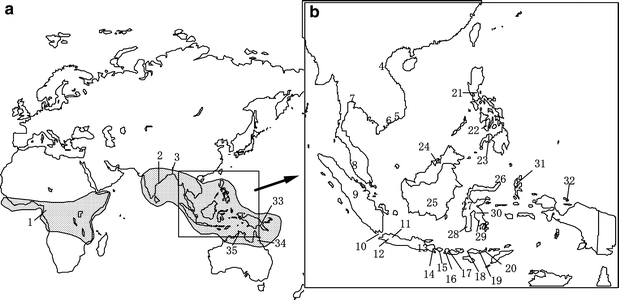
(Azuma et al. 2006 "Maps of Europe, Africa, and Asia (a) and Southeast Asia (b) showing collection sites. Numbers correspond to locality codes given in Table
1. The current distribution areas of Oecophylla longinoda (Africa) and O. smaragdina (Asia and Oceania) are enclosed by a solid line in (a)" Map. Jan 2005. URL:http://www.springerlink.com/content/m0hl5856vl15j725/(accessed on 26 Oct 2011).
Taxonavigation
Ordo: Hymenoptera Familia: Formicidae Genus: Oecophylla| Taxonomic Hierarchy |
||||
| Kingdom |
Animalia - Animal, animals, animals |
|||
| Phylum |
Arthropoda - arthropods, arthropods, Artrópode |
|||
| Subphylum |
Hexapoda - hexapod |
|||
| Class |
Insecta - Hexapoda, insects, insects, inseto |
|||
| Subclass |
Pterygota - winged insects, winged insects |
|||
| Infraclass |
Neoptera - modern, wing-folding insects |
|||
| Order |
Hymenoptera - Abelha, ants, bees, formiga, vespa, wasps |
|||
| Suborder |
Apocritical - bees, ants, bees, ants, wasps true, narrow-waisted hymenopterans, true wasps |
|||
| Infraorder |
Aculeata |
|||
| Superfamily |
Vespoidea - vespoid wasps |
|||
| Family |
Formicidae - ants, ants |
|||
| Subfamily |
Formicinae |
|||
| Tribe |
Oecophyllini |
|||
| Genus |
Oecophylla Smith, 1860 |
|||
| Species |
Oecophylla smaragdina (Fabricius, 1775) |
Synonyms
Other names that have been given| Taxon |
Status |
Relationship Type |
| Oecophylla viridis (Kirby) |
Subsequent name/combination |
Junior synonym |
| Formica macra Guérin-Méneville |
Original name/combination |
Junior synonym |
| Formica virescens Fabricius |
Original name/combination |
Junior synonym |
| Formica viridis Kirby |
Original name/combination |
Junior synonym |
| Formica zonata Guérin-Méneville |
Original name/combination |
Junior synonym |
| Oecophylla zonata (Guérin-Méneville) |
Subsequent name/combination |
Junior synonym |
| Oecophylla virescens (Fabricius) |
Subsequent name/combination |
Junior synonym |
| Oecophylla smaragdina virescens (Fabricius) |
Subsequent name/combination |
Junior synonym |
| Lasius virescens (Fabricius) |
Subsequent name/combination |
Junior synonym |
| Oecophylla smaragdina var. virescens (Fabricius) |
Subsequent name/combination |
Junior synonym |
| Oecophylla macra (Guérin-Méneville) |
Subsequent name/combination |
Junior synonym |
| Oecophylla smaragdina r. virescens (Fabricius) |
Subsequent name/combination |
Junior synonym |
| Oecophylla smaragdina st. virescens (Fabricius) |
Subsequent name/combination |
Junior synonym |
| Oecophylla smaragdina subsp. virescens (Fabricius) |
Subsequent name/combination |
Junior synonym |
| Echophylla virescens (Fabricius) |
Unavailable, literature misspelling |
Junior synonym |
| Formica smaragdina Fabricius |
Original name/combination |
Obsolete combination |
| Camponotus smaragdinus (Fabricius) |
Subsequent name/combination |
Obsolete combination |
| Formica Smaragdina Fabricius |
Subsequent name/combination |
Obsolete combination |
| Oecophylla (Formica) smaragdina (Fabricius) |
Subsequent name/combination |
Obsolete combination |
Included Taxa
Groups below species level such as subspecies recognized as possessing distinct characteristics occurring usually because of geographic isolation| Taxon |
Status |
Validity |
| Oecophylla smaragdina fuscoides Karavaiev |
Subsequent name/combination |
valid |
| Oecophylla smaragdina gracilior Forel |
Subsequent name/combination |
valid |
| Oecophylla smaragdina gracillima Emery |
Subsequent name/combination |
valid |
| Oecophylla smaragdina selebensis Emery |
Subsequent name/combination |
valid |
| Oecophylla smaragdina smaragdina (Fabricius) |
Subsequent name/combination |
valid |
| Oecophylla smaragdina subnitida Emery |
Subsequent name/combination |
valid |
Diagnosis
How to tell this species from othersW. TL 8–10 mm. Yellowish red. Head quadrangular without mandibles; mandibles long, dentate, apical tooth acute and curved; clypeus strongly convex; antennae 12-segmented. Thorax elongate; pronotum convex, anteriorly narrowed into collar; mesonotum saddle-shaped; metanotum rounded above. Petiole elongate, scarcely nodiform; abdomen short, oval (Ghosh et al., 2005).Description
Morphological features for species identificationOriginal Description
The first description of this species published"Queen: Smaragdina 1-2 FORMICA viridis, thorace flavo fublineato.Habitat in India. Edler.Magna, viridis. Antennae apice fubrufefcentes. Thorax craffus, elevatus, viridis, flavo fublineatus. Squama petiolaris, brevis, emarginata. Abdomen rotundatum, glabrum, viride. Alae magnae, albae, nervis ferrugineis" (Fabricius, 1775)."Worker: length about 4-10th of an inch; head long, triangular; antennae long; eyes large, medial; jaws triangular, pointed, with sharp teeth; thorax not furrowed; abdominal pedicle, long, low, narrow, linear; legs long ; colour of an uniform pale rufous.Male: 7-24th of an inch long; head diamond shaped; eyes lateral, small; thorax raised in front; abdomen small; wings reaching beyond the abdomen; of a rufous colour.Female:7-8th of an inch long ; head short, triangular; eyes lateral; three ocelli; thorax very large, wide ; abdominal pedicle wide in the middle as viewed from above, very thin laterally; abdomen large; wings reaching beyond abdomen; entirely of a pale shining green colour" (Jerdon, 1851).
Original Description ReferencesOecophylla smaragdina. Formica smaragdina Fabricius, 1775: 828 (q.) INDIA. Jerdon, 1851: 121 (w.m.); Wheeler, G.C. & Wheeler, J. 1953e: 176 (l.); Crozier, 1970: 115 (k.). Combination in Oecophylla: Smith, F. 1860b: 102. Senior synonym of viridis: Smith, F. 1857a: 53; Taylor & Brown, D.R. 1985: 127; of macra, zonata: Roger, 1863b: 10; Dalla Torre, 1893: 176; of virescens: Mayr, 1872: 143; Taylor & Brown, D.R. 1985: 127. Current subspecies: nominal plus fuscoides, gracilior, gracillima, selebensis, subnitida.From: AntCat
Adult Worker
Worker medium-sized, slender, slightly polymorphic. Head rather large, broader behind than in front, with rounded sides and posterior corners and semicircularly excised occipital border, very convex above. Eyes large, convex, broadly elliptical, situated in front of the middle of the head. Ocelli absent. Palpi very short, maxillary pair 5-jointed, labial pair 4-jointed. Mandibles long and large, triangular, with nearly straight lateral borders, a very long curved apical tooth and numerous short denticles along the straight apical border. Clypeus very large and convex, but not distinctly carinate, its anterior border entire or very feebly sinuate in the middle, depressed and projecting over the bases of the mandibles. Frontal area rather large, subtriangular; frontal carinae moderately long, subparallel. Antennae very long, 12-jointed, the scapes inserted some distance from the posterior corners of the clypeus, rather abruptly incrassated at heir tips; the first funicular joint very long and slender, longer than the second and third together, joints 2 to 5 much shorter, subequal, slender, the remaining joints except the last, shorter and distinctly thicker. Thorax long and narrow; pronotum longer than broad, evenly convex above, narrowed and colliform anteriorly; mesonotum anteriorly long and constricted, subcylindrical, suddenly broadened behind where it joins the small, short, unarmed epinotum, which is rounded and convex above and without distinct base and declivity. Petiole long and slender, much longer than bioad, subcylindrical, with a very low rounded node near its posterior end, its ventral surface near the middle more or less convex, its posterior border on each side with a small rounded, projecting lamella, appearing like an acute tooth when the segment is viewed from above. Gaster short, broadly elliptical, its first segment suddenly contracted to the petiole, the tip rather pointed. Legs very long and slender; claws, pulvilli, and last tarsal joint enlarged. Gizzard with long slender sepals, which are not reflected at their anterior ends (Wheeler, 1922).Phylogenetics
Position of the species relative to other ant species on the Tree of LifeThe Formicinae subfamily behaves as a stable group. Formica (Formicini) and Lasius (Lasiini) seem related, being always part of the same clade. Oecophylla (Oecophyllini) seems more closely related to the Camponotini than to Formica and Lasius in the tree obtained (Fig. 4) (Estruc et al., 2004).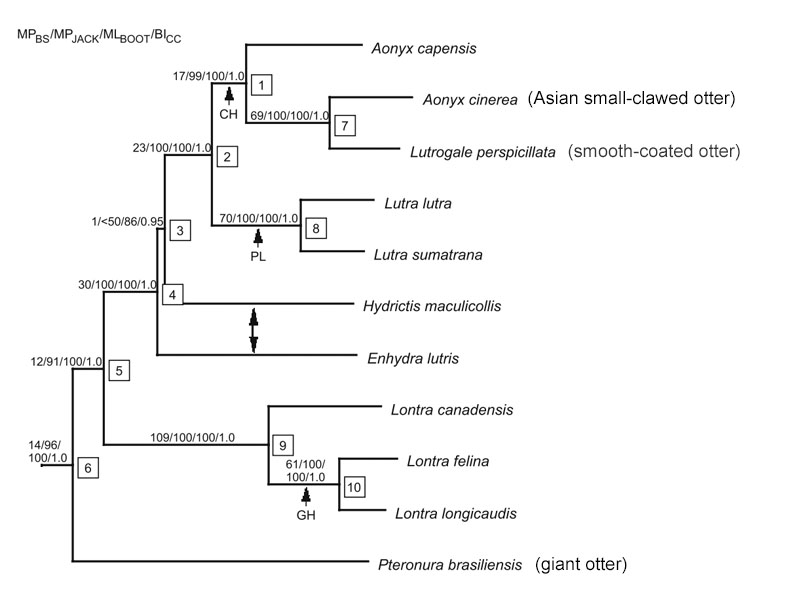 (Estruc et al., 2004 "Maximum-parsimony consensus tree from 1000 bootstrap replicates, obtained from the “Total Evidence” dataset, in the 35 species where both abd-A and Ubxsequences are available. Percentage of 1000 bootstrap trees are indicated.". Phylogenetic Tree. Feb 2004. URL: http://www.sciencedirect.com/science/article/pii/S1055790303003993 (accessed on 2 Nov 2011). |
Phylogenetic analyses suggest that the group 1 was established first, followed by the dispersal from Asia to Australia through Sulawesi and New Guinea but perhaps not through Lesser Sunda Islands. After the ancestral colonies reached Australia and New Guinea, settled in, and started to disperse, O. smaragdina diverged into the present populations in the area of group 2. The radiation in group 2 is estimated to have started in the middle Pleistocene, and this dating is consistent with the transgression and regression of the land area in Asia (Azuma et al., 2005).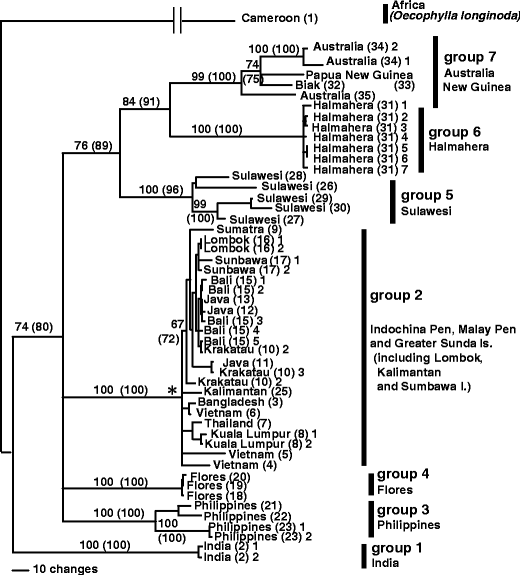 (Azuma et al., 2006 "Neighbor-joining tree using all substitutions based on the GTR+I+R model inferred from 56 of the concatenated sequences of the COI gene (1,026 bp) and the Cytb gene (647 bp) in Oecophylla smaragdina, with O. longinoda as an outgroup. Numbers above or below branches are bootstrap probability values derived from 1,000 replications; adjacent numbers in parentheses are bootstrap values (%) for the same nodes based on weighted maximum parsimony analyses from 300 replications". Phylogeographic Tree. Jan 2006. URL: http://www.springerlink.com/content/m0hl5856vl15j725/ (accessed on 26 Oct 2011). |
Type Information
First specimens from which original descriptions of the species were made, with storage location.Oecophylla Smith, F. 1860b: 101. Type-species: Formica virescens (junior synonym of Formica smaragdina), by subsequent designation of Bingham, 1903: 310.1. Formica smaragdina Fabricius, J. C. (1775). Systema Entomologiae, sistens insectorum classes, ordines, genera, species, adiectis synonymis, locis, descriptionibus, observationibus. Kortii : Flensburgi et Lipsiae xxvii. 832 pp. [p. Appendix, 828] (combination as Oecophylla smaragdina by Smith 1860:102].
Type Material: Syntype, India (ZMUK (Kiel): 2 workers). Currently on loan to Natural History Museum of Denmark, University of Copenhagen. Both specimens are alates and not in very good condition, they show evidence of dermestid attack.
References: Smith, F. (1860). Catalogue of hymenopterous insects collected by Mr A.R. Wallace in the Islands of Bachian, Kaisaa, Amboyne, Gilolo, and at Dory in New Guinea. J. Linn. Soc. Zool. 4 (suppl.) : 93-143 pl. 1 [taxonomy, p. 102]
2. Formica virescens Fabricius, J. C. (1775). Systema Entomologiae, sistens insectorum classes, ordines, genera, species, adiectis synonymis, locis, descriptionibus, observationibus. Kortii : Flensburgi et Lipsiae xxvii. 832 pp. [p. 392] (junior synonym of Oecophylla smaragdina by Mayr 1872:143).
Type Material: Syntype, Australia (as New Holland) (BMNH (London): 2 workers).
References: Mayr, G. (1872). Formicidae Borneenses collectae a J. Doria et O. Beccari in territorio Sarawak annis 1865-1867. Annali del Museo Civico di Storia Naturale. 2 : 133–155 [taxonomy, p. 143]
3. Formica viridis Kirby, W. F. (1819). A description of several new species of insects collected in New Holland by Robert Brown, Esq. F.R.S. Lib. Linn. Soc. Transactions of the Linnean Society of London. 12 : 454–478 [p. 478] (junior synonym of Oecophylla smaragdina by Smith 1858:17).
Type Material: Syntype, northern Australia (BMNH (London): worker).
References: Smith, F. (1858). Catalogue of hymenopterous insects in the collection of the British Museum. Part 6. Formicidae. London : British Museum. pp. 1–216. [taxonomy, p. 17]
From: Australian National Insect Collection Database
Type Localities
Where the type specimens were collected fromType location India (Formica smaragdina, Fabricius, 1775: 828, queen; Jerdon, 1851: 121, worker & male); subspecies (in Bolton, 1995: 298) fuscoides (Karavaiev, 1933a: 315, worker) from Java, gracilior (Forel, 1911b: 208, worker & queen) from Java, gracillima(Emery, 1893a: 195, worker) from Indonesia, selebensis (Emery, 1893a: 195, worker) from Sulawesi and subnitida (Emery, 1892d: 565, worker) from New Guinea; junior synonyms viridis (Formica viridis, Kirby, 1819: 478, worker; synonymy F Smith, 1857a: 53; Taylor & Brown, 1985:127) from Australia, macra (Guérin-Méneville, 1831, illustrated, worker) from "Offack", virescens (Fabricius, 1775: 392, worker) from Australia; and zonata (Guérin-Méneville, 1831: 205, queen) from "Port Praslin".From: Ants of AfricaOecophylla smaragdina (Fabricius, 1775 Ref.2636): 828 (appendix) - Worker; Type locality: India. (Formica smaragdina) (Current Combination: Fr. Smith; 1860 Ref.1228 : 102). = virescens (Fabricius, 1775 Ref.2636): 392 - Worker; Type locality: New Holland (probably Queensland) (Formica virescens) (Synonymy: Mayr; 1872 Ref.1922: 143). = viridis (W. Kirby, 1818): 478 - Worker; Type locality: northern Australia (probably Queensland) (Formica viridis) (Synonymy: Fr. Smith; 1858 Ref.1223: 17).From: Japanese Ant Image Database
Literature and References
Allan, R.A. and Elgar, M.A. 2001. Exploitation of the green tree ant, Oecophylla smaragdina, by the salticid spider Cosmophasis bitaeniata. Australian Journal of Zoology, Vol. 49, pp. 129-137. (http://www.publish.csiro.au/?act=view_file&file_id=ZO00088.pdf)Astruc, C., Julien, J.F., Errard, C., Lenoir, A. 2004. Phylogeny of ants (Formicidae) based on morphology and DNA sequence data. Molecular Phylogenetics and Evolution, Vol. 31, Issue 3, pp. 880-893. (http://www.sciencedirect.com/science/article/pii/S1055790303003993)
Azuma, N., Ogata, K., Kikuchi, T. and Higashi, S. 2005. Phylogeography of Asian weaver ants, Oecophylla smaragdina. Ecological Research, Vol. 19, No. 11, 1321-1328. (http://www.springerlink.com/content/m0hl5856vl15j725/)
Césard, N. 2004: Harvesting and commercialisation of kroto (Oecophylla smaragdina) in the Malingping area, West Java, Indonesia. In: Kusters, K. & Belcher, B. (Eds.): Forest products, livelihoods and conservation. Case studies of non-timber forest product systems. Center for International Forestry Research, Jakarta, pp. 61-78. (http://horizon.documentation.ird.fr/exl-doc/pleins_textes/divers09-03/010043524.pdf)
Chapuisat, M. and Keller, L. 2002. Division of Labour Influences the Rate of Ageing in Weaver Ant Workers. Proceedings: Biological Sciences, Vol. 269, No. 1494 (May 7, 2002), pp. 909-913. (http://www.jstor.org/pss/3067780)
Chung, A. 1995. Common Lowland Rainforest Ants of Sabah. Sabah Forestry Department, Sabah. 60 pp.
Cole, A.C. Jr., and J.W. Jones, Jr. 1948. A Study of the Weaver Ant, Oecophylla smaragdina (Fab.). American Midland Naturalist, Vol. 39, No. 3 (May, 1948), pp. 641-651. (http://www.jstor.org/pss/2421529)
Crozier, R.H., Newey, P.S., Schluns, E.A. and Robson, S.K.A. 2010. A masterpiece of evolution – Oecophylla weaver ants (Hymenoptera: Formicidae). Myrmecological News, Issue 13, pp. 57-71. (http://www.myrmecologicalnews.org/cms/images/pdf/volume13/mn13_57-71_printable.pdf)
Dirks, J. and Federle, W. 2011. Mechanics of Fluid Production in Smooth Adhesive Pads of Insects. Journal of the Royal Society. Vol. 8, pp. 952-960. (http://rsif.royalsocietypublishing.org/content/8/60/952.short)
Fabricius, J.C. 1775. Systema Entomologiae, sistens insectorum classes, ordines, genera, species, adjectis synonymis, locis, descriptionibus, and observationibus. Libraria Kortii, Flensburgi et Lipsiae. p. 828. (http://www.biodiversitylibrary.org/pdf3/008392600082400.pdf)
Ghosh, S.N., Sheela, S. and Kundu, B.G. 2005. Ants (Hymenoptera : Formicidae) of Rabindra Sarovar, Kolkata. Records of the Zoological Survey of India, Occasional Paper No. 234 : 1-40 (Published by the Director, Zool. Surv. India, Kolkata). (http://gap.entclub.org/taxonomists/Ghosh/Zoological%20Survey_Occasional%20Paper%20234_5.1.2011.pdf)
Jerdon, T.C.1851. A catalogue of the species of ants found in southern India. Madras Journal of Literature and Science. Vol. 17, pp. 103-127. (http://antbase.org/ants/publications/4764/4764.pdf)
Newey, P. 2011. Not one odour but two: A new model for nestmate recognition. Journal of Theoretical Biology, Vol. 270, Issue 1, 7 February 2011, pp. 7-12. (http://www.sciencedirect.com/science/article/pii/S0022519310005631)
Oudhia, P. 2002. Traditional medicinal knowledge about red ant Oecophylla smaragdina (FAB.) [Hymenoptera; Formicidae] in Chattisgarh, India. – Insect Environment Volume 8, pp. 114-115.
Schlüns, E., Wegener, B., Schlüns, H., Azuma, N., Robson, S. K. A. and Crozier, R. H. 2009. Breeding system, colony and population structure in the weaver ant Oecophylla smaragdina. Molecular Ecology, Vol. 18, pp. 156–167. (http://onlinelibrary.wiley.com/doi/10.1111/j.1365-294X.2008.04020.x/suppinfo)
Sinzogan, A.A.C., Van Mele, P. and Vayssieres, J.F. 2008. Implications of on-farm research for local knowledge related to fruit flies and the weaver ant Oecophylla longinoda in mango production. International Journal of Pest Management, Volume 54, pp. 241-246. (http://www.agroinsight.com/downloads/Articles-Sustainable-Agriculture/8_IJPM%20Knowledge%20on%20fruit%20fly%20and%20weaver%20ant%20in%20Benin%20-%20Sinzogan%20et%20al2008.pdf)
Sribandit, W., Wiwatwitaya, D., Suksard, S. and Offenberg, J. 2008. The importance of weaver ant (Oecophylla smaragdina Fabricius) harvest to a local community in Northeastern Thailand. Asian Myrmecology, Vol. 2, pp. 129-138. (http://www.asian-myrmecology.org/publications/sribandit-et-al-am-2008.pdf)
Tsuji, K., Hasyim, A., Harlion and Nakamura, K. 2004, Asian weaver ants, Oecophylla smaragdina, and their repelling of pollinators. Ecological Research, Vol. 19, pp. 669–673. (http://onlinelibrary.wiley.com/doi/10.1111/j.1440-1703.2004.00682.x/abstract)
Wheeler, W.M. 1910. Ants of the American Museum Congo Expedition. Bulletin of the American Museum of Natural History, 45:xi+ 1139. (http://www.jstor.org/pss/2421529)
Other Resources1. Naturia: http://www.naturia.per.sg/buloh/inverts/weaver_ants.htm2. Ants Down Under: http://anic.ento.csiro.au/ants/biota_details.aspx?BiotaID=371593. AntWeb: http://www.antweb.org/description.do?rank=species&name=smaragdina&genus=oecophylla&project=philippinesants4. AntArk: http://www.antark.net/ant-species/weaver-ant-oecophylla-smaragdina.html5. Encyclopedia of Life: http://eol.org/pages/457834/overview6. Hymenoptera Online Database: http://hol.osu.edu/index.html?id=33040
Feedback/Comments
| Subject | Author | Replies | Views | Last Message |
|---|---|---|---|---|
| No Comments | ||||
Genbank Records
| Entrez |
PubMed |
Nucleotide |
Protein |
Genome |
Structure |
PMC |
Taxonomy |
Books |
| Search for as complete name wild card token set phonetic name taxonomy id lock |
| levels using filter: none mapview has genome sequences has trace records |
External Information Resources (NCBI LinkOut)
| LinkOut |
Subject |
LinkOut Provider |
| DNA barcoding : Oecophylla smaragdina |
taxonomy/phylogenetic |
Barcodes of Life |
| Oecophylla smaragdina |
taxonomy/phylogenetic |
Catalog of Life |
| Oecophylla smaragdina (Fabricius, 1775) |
taxonomy/phylogenetic |
Encyclopedia of life |
| Oecophylla smaragdina |
taxonomy/phylogenetic |
Hymenoptera Name Server |
| Oecophylla smaragdina (Fabricius, 1775) |
taxonomy/phylogenetic |
Integrated Taxonomic Information System |
| Oecophylla smaragdina |
taxonomy/phylogenetic |
Plazi |
| Wikipedia |
taxonomy/phylogenetic |
iPhylo |
Information from sequence entries
Show organism modifiers
Disclaimer: The NCBI taxonomy database is not an authoritative source for nomenclature or classification - please consult the relevant scientific literature for the most reliable information.
Comments and questions to info@ncbi.nlm.nih.gov